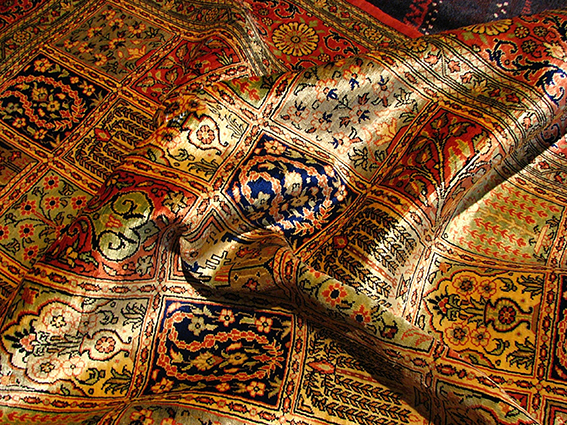Iranians are among carpet–weaving pioneers who achieved an unparalleled level of perfection through centuries, as the skill of carpet weaving has been handed down from one generation to another.
Through thousands of years, Persian carpets became globally known as Iran’s trademark. The exquisite beauty of these carpets is cherished by the growing number of customers and has made Iran the largest hand-woven carpet exporter worldwide.
Recently, however, Iran lost that crown to its rivals due to sanctions imposed on the country over its nuclear energy program and the relentless competition from cheap, mass-produced copies of traditional Iranian designs.
In anticipation of the new economic climate following the landmark July 14 nuclear accord between Iran and six world powers (the United States, Britain, France, Russia, China and Germany), which will curb its nuclear program in exchange for lifting the sanctions, carpet producers and exporters are expecting to make a comeback, Donya-e-Eqtesad reported.
To this end, new approaches are required and experts believe that focusing on accommodating new international demands and tastes and advertising this precious commodity in overseas markets is the way to go. However, challenges need to be overcome.
According to Managing Director of Iran Carpet Company Mohammad Reza Abed, the absence of a famous Iranian hand-woven carpet brand is the main issue hindering its wider publicity and marketing.
A combination of volatile political and economic conditions and the failure of establishing a national hand-woven carpet trademark has created an atmosphere in which middlemen and exporters, who purchase carpets from small-scale producers cheaply and sell the same at exorbitant rates overseas, are controlling the market.
Iran’s carpet retailers are mostly from the middle class and have a limited financial risk capability. They cut corners to lock in the most profit, but the continuation of this trend will adversely affect the quality of Persian carpets.
More affluent carpet exporters cater to their niche market and uphold their reputation.
Advertising falls prey to this mindset. Carpet sellers prefer to keep to their traditional ways instead of bearing the cost of conducting wide-scale publicity, as they are not confident about its guaranteed return.
Chairman of Tabriz’s Association of Hand-Woven Carpet Producers Esmaeil Chamani believes that in order to make a comeback, all possible means must be utilized to make the potential carpet customers appreciate the qualities of Iranian hand-woven carpets and realize “why they need to have it.”
“Iranian carpets’ aesthetics and harmony have significant potential in its utility in modern houses and as decorations. We have to use new, more consumer-friendly patterns in carpet weaving to be able to promote Iranian hand-woven carpets as the new phenomenon in house decoration and interior design,” he said.
Chamani believes that a “fundamental overhaul” of the design and color used in Iranian hand-woven carpets is necessary, since the insistence of producers to stick to traditional designs and colors has delivered the main blow to the industry, while costing it millions of potential customers.
“We have to redefine our designs, colors and even the size of the carpets we produce to match the architecture of other countries and present Iranian hand-woven carpets as the most beautiful, ancient and prestigious commodity,” he said.
Echoing these remarks, Managing Director of Azim Carpet House Ahad Azimzadeh also said the continued production of traditional carpets is the main issue hindering its growth.
“Iranian hand-woven carpets are exceptional, but even outstanding commodities must conform to the consumers’ tastes and demands to keep their market share,” he said.
Azimzadeh emphasized that lack of understanding about new tastes and demands has caused thousands of carpets to be piled up in warehouses, while India, Pakistan and Nepal are able to pre-sell their carpets months in advance.
“Hand-woven carpet production experts must be consulted to initiate new production trends and prepare for reentering international markets,” he said.
Azimzadeh called on the government to support the industry by allocating subsidies to hand-woven carpet producers so that they can again shine on the new economic horizon.
Persian carpets worth $330 million headed to 80 countries over the past Iranian year (ended March 20, 2015) in the face of western sanctions against Iran, according to the head of Iran National Carpet Center, Hamid Kargar.
During the first five months of the current Iranian year, he says, over 1,400 tons of hand-woven carpets worth about $80 million were exported.
Exports of Persian carpet faced challenges after US sanctions intensified in late 2010.
Kargar says carpet exports are expected to increase considerably following the lifting of sanctions in early 2016.


